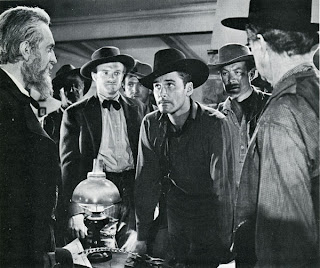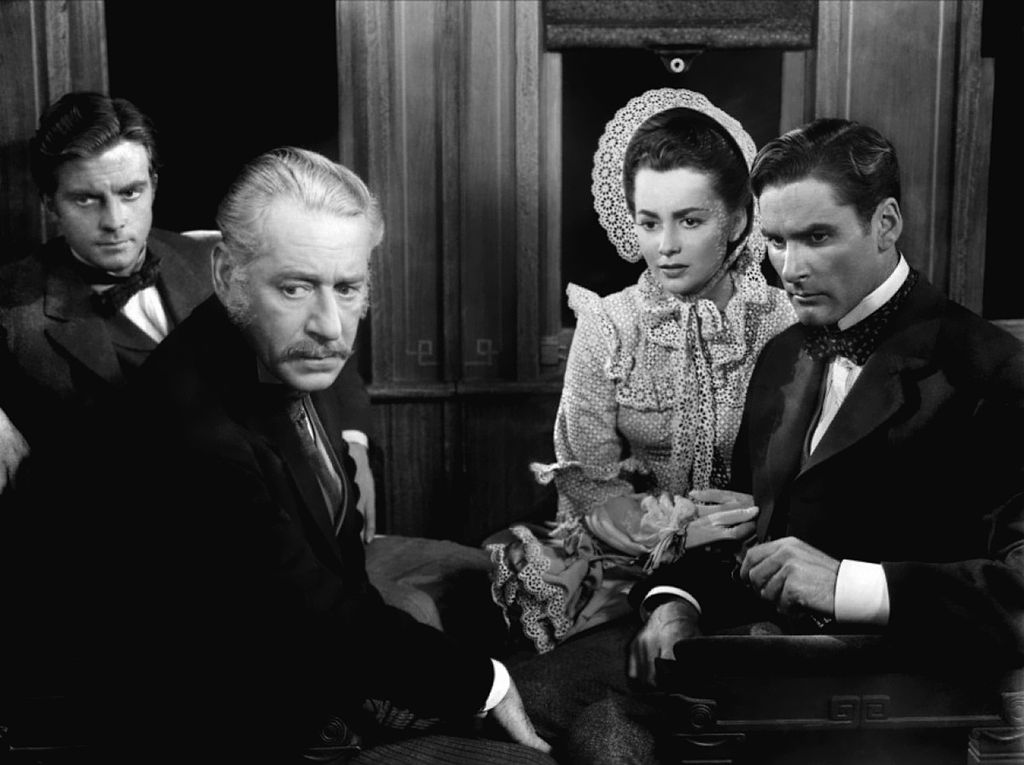You can sense the lingering images of Gone With the Wind (1939) on movie screens when this film was released
in 1940. With its Southern sympathies, it has much of the same view of Civil
War era history. Though shot in black and white, the scale of many scenes, the
size of the cast, and especially the appearance of Olivia De Havilland in a
full antebellum dress, also bring that earlier film to mind.
Coming up: Old West glossary, no. 42
Plot. Its opening
scenes set in 1854, the film introduces us to its central characters, J.E.B.
Stuart (Errol Flynn) and George Armstrong Custer (Ronald Reagan). De Havilland
is with a contingent from Kansas at their West Point graduation ceremonies. In a secondary
role is Van Heflin, expelled from the academy for distributing anti-slavery
literature in the cadets’ quarters. A monumental presence in the film is
Raymond Massey’s stormy and apparently mad abolitionist, John Brown.
The characters all converge in Bleeding Kansas as pro- and
anti-slavery forces take up arms against each other. Heflin, we learn, has become a strategic military advisor to Massey. But before engaging Massey’s army of volunteers, best friends Flynn and Reagan amicably woo de Havilland. Her father is a
Kansas merchant with a vision of building a railroad from Fort Leavenworth to
Santa Fe.
 |
| (Left to center) Raymond Massey, Van Heflin, Errol Flynn |
Flynn, wearing a handsome black hat, is taken captive by
Massey and escapes both hanging and a burning barn before being rescued by the
cavalry, with Reagan in command. Defeated, Massey and his followers are driven
from Kansas, only to turn up again at Harper’s Ferry.
Disenchanted with Massey, Heflin goes to Washington to
reveal the man’s plans to incite a slave rebellion. Flynn and Reagan lead
the charge that lays siege at Harper’s Ferry and take Massey captive. He is
eventually hanged. Meanwhile, tracks for the new railroad are being laid along
the Santa Fe Trail and de Havilland has decided it is Flynn she wants for a
husband. The disappointed Reagan is quickly introduced to a fetching blonde who
turns out to be the daughter of Jefferson Davis.
 |
| Ronald Reagan, Olivia de Havilland, Errol Flynn |
History vs. bunk. The
portrayal of J.E.B. “Jeb” Stuart comes fairly close to actual history. Stuart,
who was later to be a Confederate general, did graduate from West Point in
1854, in time to receive a commission that put him in Kansas during John
Brown’s tenure there.
As an officer in the military, Stuart was called upon to
support the pro-slavery government of the Territory and to help quell the
growing violence and bloodshed. In a whirlwind courtship, he also met and
married Flora Cooke, the daughter of a lieutenant colonel.
The specifics of John Brown’s activities in Kansas are
probably manufactured. But his portrayal as a fiery, Scripture-quoting domestic
terrorist squares with the estimation of some, though not all, historians. His
capture and attempted hanging of Stuart is an invention by the screenwriter.
Ronald Reagan’s George Custer is more of a fabrication.
Custer was still at West Point during John Brown’s crusade and graduated with
the rest of his class, a year early, when the Civil War broke out in 1861. Reagan’s
big grin gives Custer more the manner of a good-time fraternity bloke, although
from what we know of the man’s career as a cadet, that’s probably not too far
off the mark.
 |
| Henry O'Neil, Olivia de Havilland, Errol Flynn (foreground) |
Implications. The
pro-South bias of the film doesn’t make it a Birth of a Nation,
but there are moments that have an odd ring to them. Flynn says more than once
that the slave states should be left to work out their own future with no
interference from outsiders. When the outsiders are cast as murderous followers
of the Rasputin-bearded John Brown, and there’s little mention of equally
militant slavery advocates, you have to wonder.
A handful of black actors get lines now and then in the script.
Traveling on the Underground Railroad, they can be heard lamenting the
realities of being free men. One complains about having to look after himself
now and wishes he could go back to the plantation where he didn’t have to worry
about food and shelter. Meanwhile, as an out-spoken abolitionist, Heflin loses
faith in Brown’s cause and ends up being killed.
As for the Santa Fe Railroad, the film does give proper
credit to entrepreneur Cyrus Holliday (Henry O’Neill). He had a daughter named
Lillie, who may or may not have borne a resemblance to Olivia de Havilland’s
“Kit Carson” Holliday. The railroad, however, was not built until after the
Civil War, and Lillie Holliday did not marry J.E.B. Stuart.
 |
| Guinn "Big Boy" Williams and Alan Hale (foreground) |
Wrapping up. Hungarian-born
director Michael Curtiz brought this epic-size historical drama to the screen.
In a career that spanned 50 years behind the camera, Curtiz is remembered for
classics in nearly every movie genre, from Casablanca (1942) to Yankee
Doodle Dandy (1942). Action sequences,
including a fistfight in the opening minutes, crowd scenes, a barn burning,
gunfights, rescues, and chases are well executed.
Screenwriter Robert Buckner wrote the scripts for some 40
films, including two other Errol Flynn vehicles, Dodge City (1939) and Virginia City (1940).
There’s a rousing musical number as prairie freighters set off from Fort
Leavenworth on the Santa Fe Trail. A comic underplot with veteran character
actors Alan Hale and Guinn “Big Boy” Williams plays amiably against the film’s
more serious scenes. The romancing of de Havilland by tag team Flynn and Reagan
is nicely light hearted.
Santa Fe Trail (curiously
named since little of the film has anything to do with the Santa Fe Trail) is
currently available at netflix and amazon. For more of Tuesday’s Overlooked
Movies, click on over to Todd Mason’s blog.

Weird. Or perhaps it's just the lingering resonances of seeing IN THE HEAT OF THE NIGHT again last night, and how that film keys into the resentments on every level of a dying small Southern town not quite sure how to shake off this era...
ReplyDeleteUnless you are from there, the South is one of those mysteries wrapped in an enigma.
DeleteAnother thoughtful, penetrating review. Olivia de Havilland, in her upper nineties, lives on quietly in Paris, the last of that generation.
ReplyDeleteThanks, Richard. If you're going to live that long, Paris is a perfect place to be.
DeleteI went through a period where I was fascinated with J.E.B. Stuart. I kind of wanted to ride with him. Back when I was young and naive. As a teenager that is.
ReplyDeleteNot much of a Civil War buff, so I had to learn from Wikipedia that Flynn's character was based on an actual person.
DeletePerhaps it was titled The Santa Fe Trail to lessen the emphasis on slavery. Ronald Reagan had that odd-shaped mouth which I didn't much care for. I liked him as the announcer/commentator for the 20-mule team Borax show.
ReplyDeleteMakes it sound more like a western than what it is. If I ever knew Reagan's 20-Mule connection, I'd forgotten it.
DeleteI like old movies like this one but always wish they would not use real names when the stories rarely fit what happened. I'd enjoy stories like 'My Darling Clementine' and this one more if they used fictional names.
ReplyDeleteI know what you mean. They require a different kind of suspension of disbelief.
DeleteI've argued for years that most Westerns are really Southerns. Their heroes are usually ex-Confederates and they are set in the extended South, including Texas, NM and Arizona. Southern cavalier culture generates the gunfighters. It's hard to imagine gunfighters in the more northerly West, such as Montana or Idaho or the Dakotas. The principal market for gunfight "westerns" is the South, especially Texas.
ReplyDeleteI have come to be of the same mind, Richard.
Delete